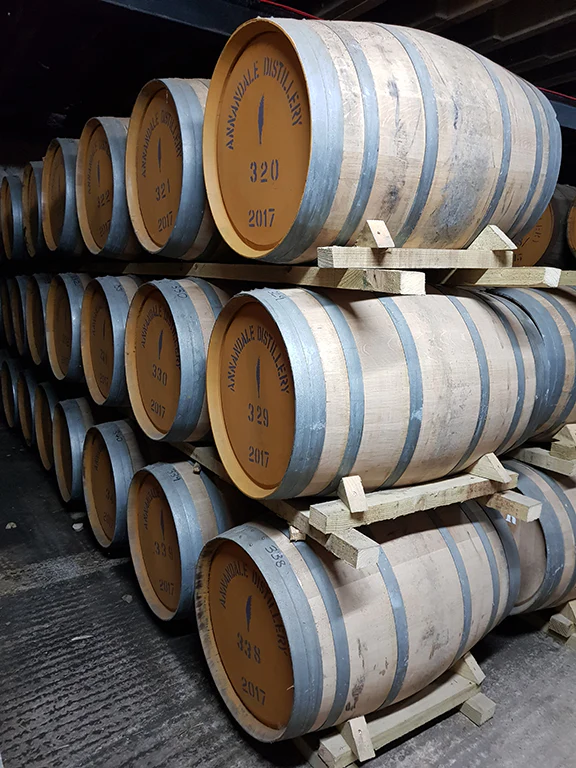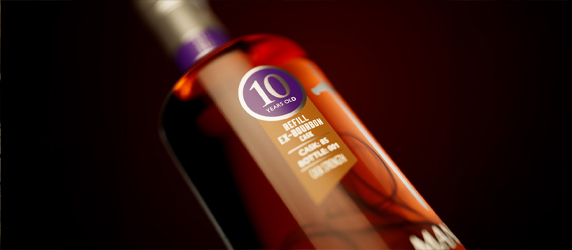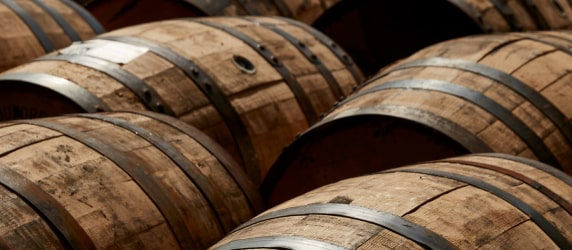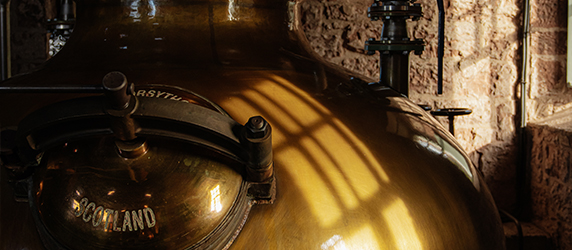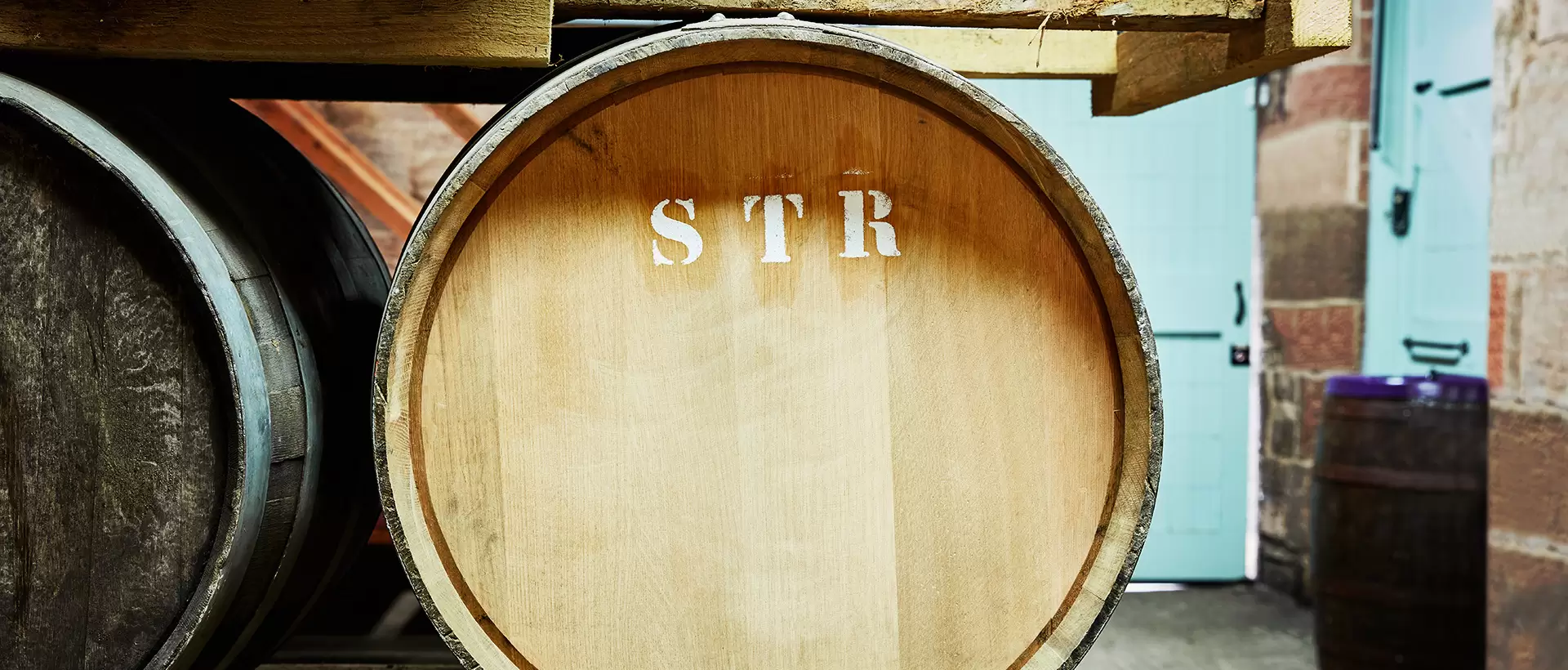STR’s
The Scotch Whisky Regulations (2009) specify that Scotch Whisky can be matured in a variety of different casks provided that the cask is made of oak and provided that it is no more than 700 litres in volume. The reason why oak is specified in law is because it has a particular effect on the maturing spirit that gives Scotch Whisky its characteristic flavour (sensory characteristics). In essence, oakwood maturation is fundamental to the flavour of Scotch Whisky.
Most of the maturation casks used in Single Malt Scotch Whisky have previously matured either bourbon, Tennessee sour mash (e.g. Jack Daniels), cognac, brandy, rum, tequila, and a multitude of wines including various red wines, white wines, sherry, Port, Madeira, etc.
Oak has three very specific effects on the maturing spirit:
1.) Extraction – the spirit extracts various flavour components from the oak, predominantly, vanillin (vanilla, sweet), various lactones (coconut, cocoa, toasted, nutty, creamy, woody, maple) and tannin (astringency and colour).
2.) Extraction – the spirit extracts residues of the prior occupant – the barrel staves will have become impregnated with vestiges of the previous occupant.
3.)Absorption – the oak absorbs various undesirable flavour compounds from the maturing spirit (especially sulphur compounds produced during fermentation).
In other words, the cask both ‘gives’ and ‘takes’ from the maturing spirit. The balance of these three effects is critical to the flavour of Scotch Whisky.
Virgin oak casks (i.e. casks that haven’t been used previously to mature other spirits or wines) are rarely used in Scotch Whisky maturation, simply because of the potency of the virgin oak extracts. In contrast, the regulations governing bourbon production in the USA (Federal Standards of Identity for Distilled Spirits – 27 CFR 5) stipulate that charred virgin oak casks must be used for maturation. It’s the extracts from virgin oak that give bourbon much of its character. (If Scotch malt spirit was matured in virgin oak, it would eventually become very bourbon-like.) The US bourbon regulations create a mountain of once-used ex-bourbon casks, the vast majority of which are bought by the Scotch Whisky industry. Consequently, much of the Single Malt Scotch Whisky produced in Scotland has a ‘hint of bourbon’ due to further extraction of flavour components from the oak, as well as the extraction of residual bourbon from the barrel staves.
In more recent times, Scotch whisky distillers have become increasingly adventurous and innovative in their choice of oak casks (see above) to either mature or finish their whisky. These different cask types produce Single Malts with flavour profiles that are distinctly different from those matured in ex-bourbon barrels.
The STR is one such innovation! STRs are ex-Burgundy (red) wine casks that have been shaved (S), toasted (T) and re-charred (R). After a cask has held Burgundy for several years (possibly as much as 7 years), the oak barrel staves will have become heavily impregnated with the wine. If such a wine cask was subsequently filled with malt spirit, it’s possible that the resulting Single Malt would be too ‘winey’ in character, too red in colour and, because the inner surfaces of the cask may have been stripped of all of its flavour compounds, there could be too little oak character.
It was the late Dr Jim Swan, a great friend and guiding light to Annandale Distillery, in collaboration with Bodegas José Y Miguel Martín (Spain), who developed the idea of carefully shaving the inside surface of Burgundy casks (to a depth that’s a closely guarded secret) to remove some of the wine-impregnated oak, thereby bringing some of the active oak, held deeper in the stave, closer to the surface. The inner surface is then toasted to break down certain structural elements in oak (particularly lignin and hemicellulose) into sugars which are subsequently caramelised by the heat (via Maillard reactions). Toasting also releases a variety of potent flavour compounds including vanillin. In the Swan/Martin STR process, toasting involves the burning of oak chips milled from redundant wine barrel staves. The temperature and duration of toasting, and the precise source and mix oak chips, is another closely guarded secret. Finally, the inner surface of the barrel is charred on a gas burner to create a charcoal (crocodile skin) surface. This is essentially activated charcoal, which has a huge surface area (due to the charring), and phenomenal adsorptive capacity for soaking-up undesirable flavour compounds. (You’ve guessed it – the extent of charring is another commercial secret!)
Whilst cask rejuvenation via shaving and re-charring isn’t new, the ‘clever’ part of the Swan/Martin STR process is leaving enough residual ‘wine effect’ whilst reactivating the oak by toasting and re-charring. This is a very difficult balancing act. It’s also worth noting that thermal reactivation, whether it’s by toasting and/or re-charring, does not recreate exactly the flavour potential of virgin oak. In particular, lactones (coconut, cocoa, toasted, nutty, creamy, woody, maple), tannins (astringency and colour) and eugenol (cloves) are not recreated. Consequently, the balance of wood extractives in regenerated casks, such as STRs is rather different from those of a new cask, which makes them interesting and different.
The Swan/Martin STR process undoubtedly brings another flavour dimension to whisky maturation…but does it create great-tasting Single Malts? Jim Swan was heavily involved in the development of Kavalan Distillery in Taiwan. In 2015, Kavalan Solist (Vinho Cask) won the accolade of the ‘Best Single Malt Whisky in the World’ (World Whisky Awards). Working with the team at Kavalan, Jim matured Solist in Swan/Martin STRs! Solist is variously described as having extra-fruity notes (melon, mango, citrus, vanilla, oak spice and dates). Not bad considering just how young this whisky was at the time of the award!
In late January 2017, Jim Swan met with David Thomson and Teresa Church, Co-Founders of Annandale Distillery. We talked about wood policy and nosed a lot of Annandale’s peated and unpeated young, maturing spirit. Jim was convinced that our spirit would mature very well in his STRs. His parting words, as he left the distillery for yet another overseas consultancy trip, were…… “Don’t forget to order a consignment of STRs from Miguel Martin!” We invariably took Jim’s advice, and so 90, 230 litre STR hogsheads were ordered. Just over two weeks later, Jim passed away. We were broken-hearted.
Fast-forward three years and Annandale’s spirit, filled into Swan/Martin STRs, has metamorphosised into peated and unpeated Single Malt Scotch Whisky. Jim was right! The union between Annandale’s malt spirit and Jim’s STRs is a marriage made in heaven.
In mid-July 2020, Annandale Distillery will launch Swan/Martin STR-matured, peated (Man O’ Sword) and unpeated (Man O’ Words) Single Cask, Single Malts under its Founders’ Selection label. It’s our tribute to the great man.
Tasting Notes (prepared by James Rogerson, Annandale’s Cask & Whisky Specialist):
Founders’ Selection Man O’ Sword (Peated) – Cask 2017/355:
Appearance – Wonderfully rich golden amber hue
Nose – Peat is subtle at first but very reminiscent of tobacco smoke and smoky bacon. This is followed by a hint of coconut and sweet almond cherry Bakewell.
Palate – A huge peat explosion, bringing in earthy notes with smouldering green foliage, creamy vanilla, fresh peach and a slight tickle of black pepper on the back of the throat.
Founders’ Selection Man O’ Words (Unpeated) – Cask 2017/321:
Appearance – Rich, golden amber
Nose – Spicy hints of cinnamon and nutmeg precede creamy vanilla, butterscotch and sweet caramelised demerara sugar
Palate – Hot melted butter initially which coats the palate, followed by hints of fresh conference pear, summer strawberries and fresh cream, Braeburn apple, blackberry, prunes and cool fresh honeydew melon
